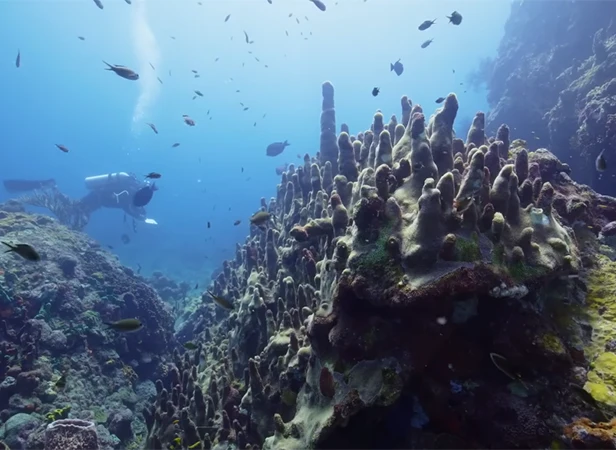Dominica’s Marine Ecosystems

Dominica’s marine ecosystems are among the most diverse and ecologically important in the Caribbean, offering rich biodiversity, vital economic resources, and significant cultural value. These ecosystems are critical in supporting fisheries, eco-tourism, and coastal resilience, from coral reefs and seagrass beds to mangroves, volcanic hydrothermal vents, and deep-sea trenches. Dominica’s commitment to marine conservation reflects its status as the Nature Island, where environmental health and economic well-being are closely interthreaded.
The Range of Marine Ecosystems
Dominica’s marine ecosystems encompass vibrant coral reefs, seagrass meadows, mangroves, deep-sea trenches, and volcanic vents, each supporting unique biodiversity and ecological functions.
Coral Reefs
Dominica’s fringing and patch reefs stretch along the western and southern coasts, providing habitat for fish, crustaceans, and coral species. Key reef sites, including those in Soufriere Scotts Head Marine Reserve and Cabrits National Park Marine Section, boast rich coral diversity, including elkhorn coral, brain coral, and staghorn coral. These reefs act as nurseries for juvenile fish and serve as natural coastal barriers against storm surges.
Seagrass Beds
Located in shallow coastal areas, particularly near Portsmouth and Castle Bruce, seagrass meadows provide feeding grounds for juvenile fish, sea turtles, and conch. Seagrasses also play a crucial role in carbon sequestration, helping mitigate climate change impacts by storing carbon dioxide in their roots and sediments.
Mangrove Forests
Though limited in extent compared to other Caribbean islands, mangrove ecosystems are found in areas like the Indian River estuary and Portsmouth wetlands. Mangroves act as natural filters, stabilize shorelines, and serve as essential nurseries for many fish species, supporting both biodiversity and coastal fisheries.
Hydrothermal Vents and Volcanic Marine Features
A unique aspect of Dominica’s marine ecosystems is its underwater volcanic activity, particularly in areas like Champagne Reef, where hot geothermal bubbles rise from the seabed. These rare habitats support specialized marine species, while also creating one of the island’s most popular dive sites, blending marine biodiversity with eco-tourism appeal.
Deep-Sea Trenches and Canyons
Just offshore, the seabed plunges into deep trenches, creating habitat for large pelagic species such as tuna, marlin, and dolphins, and providing prime conditions for whale watching. These deep waters, particularly off the western coast, also support unique deep-sea coral communities, which scientists have only begun to explore.
Biodiversity and Key Species
Dominica’s marine ecosystems support hundreds of species, including:
- Hawksbill turtles and leatherback turtles nesting on beaches.
- Sperm whales, humpback whales, and dolphins in deep offshore waters.
- Groupers, snappers, and parrotfish within coral reef habitats.
- Spiny lobsters, queen conch, and octopuses in rocky and seagrass habitats.
- Seabirds such as magnificent frigatebirds and brown boobies, which rely on nearshore habitats for feeding.
Importance to Local Communities
Fisheries and Food Security
Coastal communities, particularly in Soufriere, Scotts Head, Portsmouth, and Marigot, rely heavily on healthy marine ecosystems for fishing livelihoods. Reef and nearshore fisheries provide protein for local diets and contribute to household income, while offshore pelagic species like tuna and mahi-mahi form part of the export market.
Tourism and Recreation
Marine ecosystems also underpin Dominica’s eco-tourism sector, attracting divers, snorkelers, whale watchers, and kayakers. Sites like Champagne Reef, Scotts Head, and the Indian River feature prominently in marine tourism marketing, demonstrating the economic value of conservation.
Conservation Initiatives
Marine Protected Areas (MPAs)
Dominica established several Marine Protected Areas, including:
- Soufriere Scotts Head marine reserve
- Cabrits National Park Marine Section
These areas are managed through co-management partnerships involving the Fisheries Division, community stakeholders, and scientific experts. MPAs regulate fishing, scuba diving, and boat anchoring, balancing economic uses with biodiversity protection.
Community-Based Conservation
Several fishermen’s cooperatives and community-based organizations play roles in monitoring coral health, participating in cleanup initiatives, and conducting public awareness campaigns. Educational programs often focus on teaching sustainable fishing practices and coral reef conservation to schoolchildren and youth groups.
Climate Resilience Projects
Recognizing the vulnerability of coastal ecosystems to climate change, Dominica has incorporated marine ecosystem protection into its broader climate resilience strategies. Projects focus on:
- Coral restoration using coral nurseries.
- Mangrove replanting along vulnerable coastlines.
- Beach profiling and turtle nesting monitoring to track climate impacts.
Research and Monitoring
Collaborations with regional and international scientific organizations have strengthened marine research capacity, including reef health monitoring, fish stock assessments, and whale population surveys. Institutions such as the University of the West Indies (UWI) and the Waitt Institute have conducted marine biodiversity studies, ensuring that policy decisions are informed by scientific data.
The Future of Dominica’s Marine Ecosystems
Safeguarding marine life also safeguards Dominica’s heritage, economy, and future. As marine eco-tourism rises, so does the need for responsible access and firm conservation practices. Strengthening marine protected areas, improving fisheries policies, and expanding environmental education are essential to long-term marine health.




